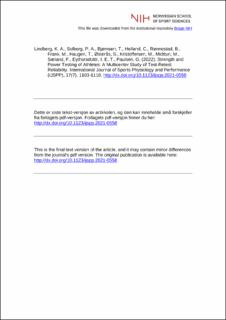| dc.contributor.author | Lindberg, Kolbjørn Andreas | |
| dc.contributor.author | Solberg, Paul André | |
| dc.contributor.author | Bjørnsen, Thomas | |
| dc.contributor.author | Helland, Christian | |
| dc.contributor.author | Rønnestad, Bent | |
| dc.contributor.author | Frank, Martin | |
| dc.contributor.author | Haugen, Tommy | |
| dc.contributor.author | Østerås, Sindre | |
| dc.contributor.author | Kristoffersen, Morten | |
| dc.contributor.author | Midttun, Magnus | |
| dc.contributor.author | Sæland, Fredrik | |
| dc.contributor.author | Eythorsdottir, Ingrid Eir Thorp | |
| dc.contributor.author | Paulsen, Gøran | |
| dc.date.accessioned | 2023-01-12T09:46:33Z | |
| dc.date.available | 2023-01-12T09:46:33Z | |
| dc.date.created | 2022-08-17T11:27:55Z | |
| dc.date.issued | 2022 | |
| dc.identifier.citation | International Journal of Sports Physiology and Performance (IJSPP). 2022, 17(7), 1103-1110. | en_US |
| dc.identifier.issn | 1555-0265 | |
| dc.identifier.uri | https://hdl.handle.net/11250/3042916 | |
| dc.description | I Brage finner du siste tekst-versjon av artikkelen, og den kan inneholde ubetydelige forskjeller fra forlagets pdf-versjon. Forlagets pdf-versjon finner du på www.humankinetics.com / In Brage you'll find the final text version of the article, and it may contain insignificant differences from the journal's pdf version. The original publication is available at www.humankinetics.com | |
| dc.description.abstract | Purpose:This study examined the test–retest reliability of common assessments for measuring strength and power of the lowerbody in high-performing athletes.Methods:A total of 100 participants, including both male (n=83) and female (n=17) athletes(21 [4] y, 182 [9] cm, and 78 [12] kg), were recruited for this study, using a multicenter approach. The participants underwentphysical testing 4 times. Thefirst 2 sessions (1 and 2) were separated by∼1 week, followed by a period of 2 to 6 months, whereasthe last 2 sessions (3 and 4) were again separated by∼1 week. The test protocol consisted of squat jumps, countermovementjumps, jump and reach, 30-m sprint, 1-repetition-maximum squat, sprint cycling, and a leg-press test.Results:The typical error(%) ranged from 1.3% to 8.5% for all assessments. The change in means ranged from−1.5% to 2.5% for all assessments, whereasthe interclass correlation coefficient ranged from .85 to .97. The smallest worthwhile change (0.2 of baseline SD) ranged from1.2% to 5.0%. The ratio between the typical error (%) and the smallest worthwhile change (%) ranged from 0.5 to 1.2. Whenobserving the reliability across testing centers, considerable differences in reliability were observed (typical error [%] ratio: 0.44–1.44).Conclusions:Most of the included assessments can be used with confidence by researchers and coaches to measurestrength and power in athletes. Our results highlight the importance of controlling testing reliability at each testing center and notrelying on data from others, despite having applied the same protocol. | en_US |
| dc.language.iso | eng | en_US |
| dc.subject | squat jump | en_US |
| dc.subject | countermovement jump | en_US |
| dc.subject | jump and reach | en_US |
| dc.subject | sprint running | en_US |
| dc.subject | sprint cycling | en_US |
| dc.subject | leg press | en_US |
| dc.title | Strength and Power Testing of Athletes: A Multicenter Study of Test-Retest Reliability | en_US |
| dc.title.alternative | Strength and Power Testing of Athletes: A Multicenter Study of Test-Retest Reliability | en_US |
| dc.type | Peer reviewed | en_US |
| dc.type | Journal article | en_US |
| dc.description.version | acceptedVersion | en_US |
| dc.source.pagenumber | 1103-1110 | en_US |
| dc.source.volume | 17 | en_US |
| dc.source.journal | International Journal of Sports Physiology and Performance (IJSPP) | en_US |
| dc.source.issue | 7 | en_US |
| dc.identifier.doi | 10.1123/ijspp.2021-0558 | |
| dc.identifier.cristin | 2043777 | |
| dc.description.localcode | Institutt for fysisk prestasjonsevne / Department of Physical Performance | en_US |
| cristin.ispublished | true | |
| cristin.fulltext | postprint | |
| cristin.qualitycode | 1 | |
